Rhododendron Problems: What’s Wrong With My Rhododendron?
Learn the common types of Rhododendron problems that may cause your normally care-free plant to be unhealthy and how to fix them.
Generally speaking, Rhododendrons are very care-free plants that don't require much maintenance at all. (You can find more about caring for your Rhododendrons HERE).
However, occasionally you may run into an issue where your plants are just not looking up to par.
Since I've had rhododendrons in my garden for so long, I have run into a few of the common rhododendron problems over the years. So I thought I would share my experiences in case you run into the same problems and need some help.
Yellow Leaves
One potential Rhododendron problem is that the leaves are turning yellow.
According to the American Rhododendron Society, if the plant has older leaves that have turned yellow between green veins, you likely have a Magnesium deficiency. Sprinkle some Epsom Salts* around the plant to correct the issue.
If the same symptom appears in new leaves, then it is likely that the soil is too alkaline. The alkalinity prevents the plant from taking in the iron that it needs to remain healthy.
For a quick fix, you can try spraying the ground and leaves with an iron sulfate* solution. While this will provide quick relief to the plant, you will probably want to look into making your soil more acidic long term. Applying some peat moss and acidic mulching materials around the plant will eventually help to bring the soil pH down.
Find out more about soil pH, testing it and changing it HERE.
Brown Spots On The Leaves
A second type of Rhododendron issue is brown spots on the leaves. There are several types of fungus that can cause this.
With the humid summers here in SC, I always seem to have at least one Rhododendron with this problem.
To fix it, I usually clean up around the plant and try to cut back a few branches to reduce overcrowding and improve the air circulation.
Although the brown spots don't look great, they don't seem to bother the plant much.
Stem Die Back
Every once in a while I have a whole stem of a Rhododendron branch that dies in the middle of an otherwise healthy-looking plant. According to the Clemson University Cooperative Extension, this is caused by another kind of fungus that gets under the bark.
It usually attacks plants that are under stress due to drought, too much sun or late frosts. So the plan of attack is to cut off the dead branch as soon as possible and then try to remedy the source of the stress (if possible).
I had one plant last year that all of the stems eventually died back, and I thought it was dead. But then, much to my surprise, it started to grow some brand new shoots from the bottom. So there is a chance that your tough rhododendron may recover.
Curled Up Leaves
If you have evergreen rhododendrons and live in an area where it gets cold in the winter, you may see the leaves curl up and look pretty unhappy during a cold spell. Don't be alarmed. The leaves are just trying to conserve water in the cold, dry air. They will open up and come back to life once it warms up.
If you see curled up leaves in the summer, though, that is a sign that your Rhododendron is much too dry. Water immediately!
Buds Don't Open
There is nothing more disappointing than seeing your Rhododendron covered in buds and then not getting any flowers!
These are the 2 common causes of this that I've seen.
Bud Blast
Bud Blast is a fungal infection that causes the buds on the Rhododendron to die and turn black before they bloom.
It isn't a life-threatening condition for the plant, but it is really disappointing for the gardener!
It is thought to be spread by the Rhododendron Leaf Hopper, an insect that doesn't do much damage to the plant other than spreading this fungus around.
You can get insecticides to kill the bugs, but I prefer to just pick off the infected blooms as soon as I see them (less detrimental to the environment). That decreases the number of fungus spores that are available to be transported and limits the spread of the issue.
Frost Bite
If you have a late frost, it's possible that the buds on your Rhododendrons were affected.
In this case, they usually turn a light brown color and get a little mushy (for lack of a better term). In other words, they look like they're been frozen and thawed.
Other than covering the plant during the frost, there isn't much you can do about this condition. But fortunately, it usually doesn't cause any lasting damage either. Unless you are trying to grow Rhododendrons that aren't zoned for your area…then you might want to look for some other varieties that won't be affected so much by the cold.
Few (Or No) Flower Buds Form
Again, there are a number of reasons why you don't have any buds on your Rhododendrons.
Incorrect Pruning Or Deadheading
The most common cause of not having any blooms is that the plant was pruned after flowering the previous year, or too much of the flower head was removed when deadheading. In this case, you'll just have to wait it out until next year…and remember not to cut off the flowering stems 🙂
Too Much Shade
Too much shade can also cause fewer (or no) blooms. While most Rhododendrons will do fine in the shade, there are some varieties that like more sun. And almost all of them will produce more blooms if they get dappled shade, rather than total shade.
Incorrect Fertilizing
Too much fertilizer applied after the plant has finished blooming is another culprit of fewer blooms. First, since the Rhododendron roots are so shallow, too much fertilizer can stunt the growth of the whole plant. Second, fertilizer applied after the plant has finished blooming mostly promotes lots of leaves…so if you are going to fertilize, be sure to apply it at the correct time.
Not Enough Water
Letting the plant get too dried out or allowing the roots to get too hot will also affect the number of buds that form. Since the buds grow during the summer, making sure that you have a thick mulch cover and that your Rhododendrons are getting at least 1″ of water per week will help it to be as healthy as it can be.
Growth On The Stems
Lichens are a combination of algae and fungus forming a partnership to help each other grow. Generally, they don't actually hurt the plant that they are living on, since they make their own food.
However, if your Rhododendrons have lichens growing on them, it usually means they are thinning because of poor growing conditions, disease or old age. So you may want to take a look at rejuvenating the plant, by pruning it or improving the area around it to make the plant happier.
I have seen this on plants that have become too crowded or are lacking in Magnesium (those yellow leaves from above).
More Information
If you want even more information about Rhododendron pests and problems, this guide from Washington State University has an extensive list of Rhododendron problems and how to fix them. You can get it for free online, or buy a printed copy.
Other Rhododendron Information You Might Like
- Rhododendron Care: How To Grow Beautiful Rhododendrons and Azaleas
- 7 Of The Best Azalea and Rhododendron Varieties
- How To Design A Stunning Shade Garden (With Pictures)
Have comments or questions on Rhododendron problems? Tell us in the section below.
Pin It So You Don't Forget It!
This post was originally published on July 11, 2017 but was updated with new content on November 23, 2024.
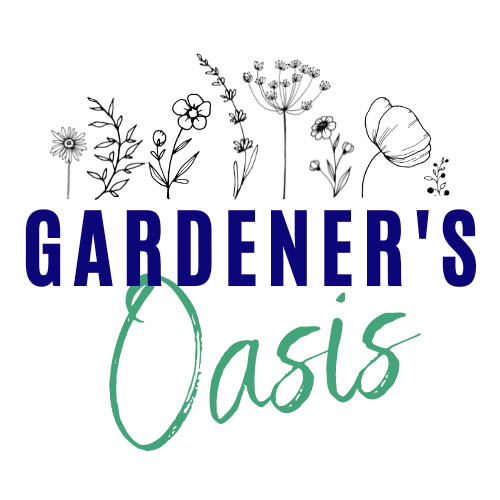














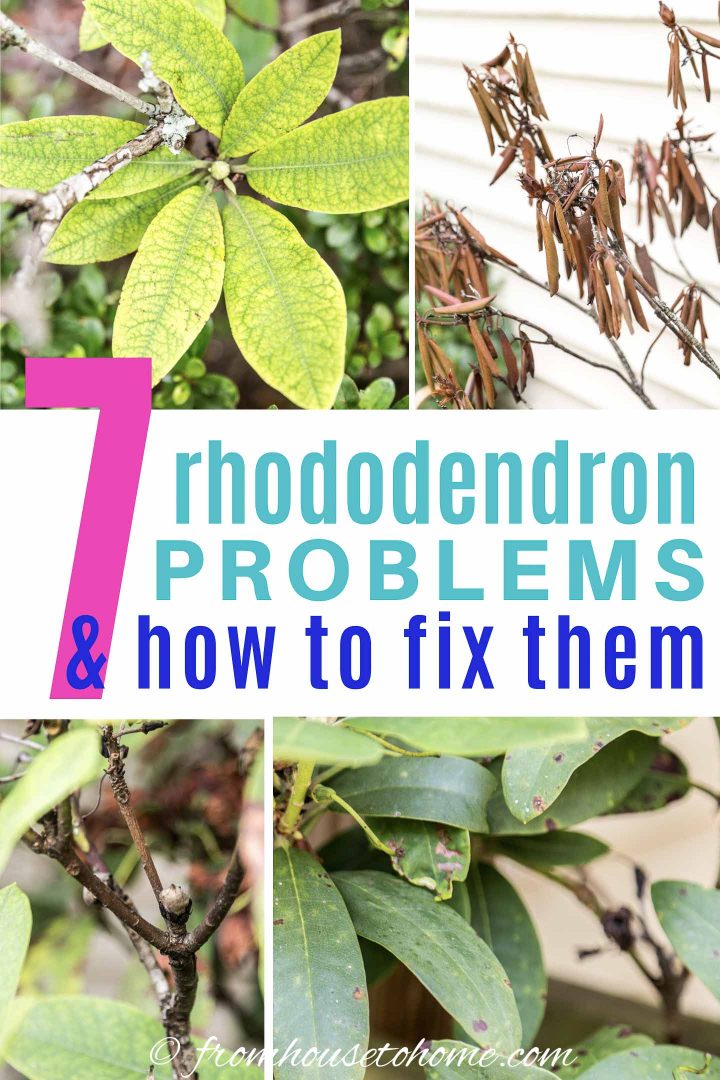
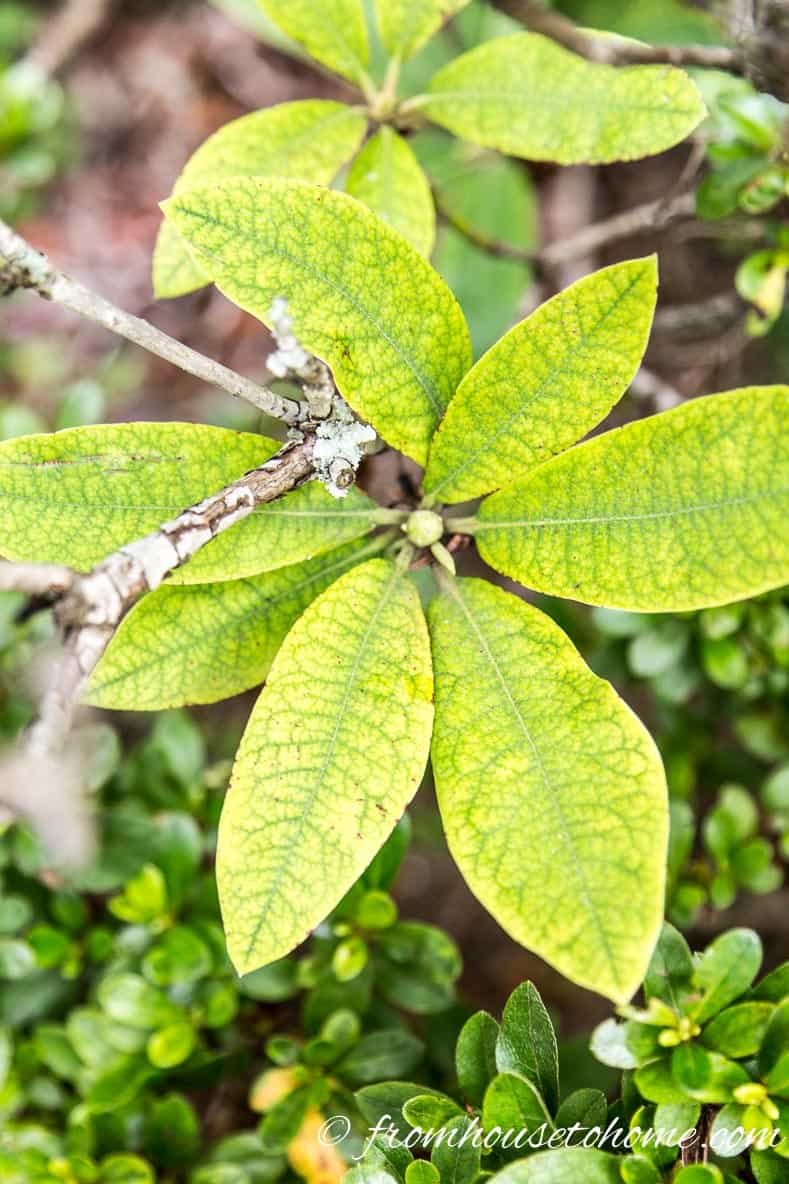


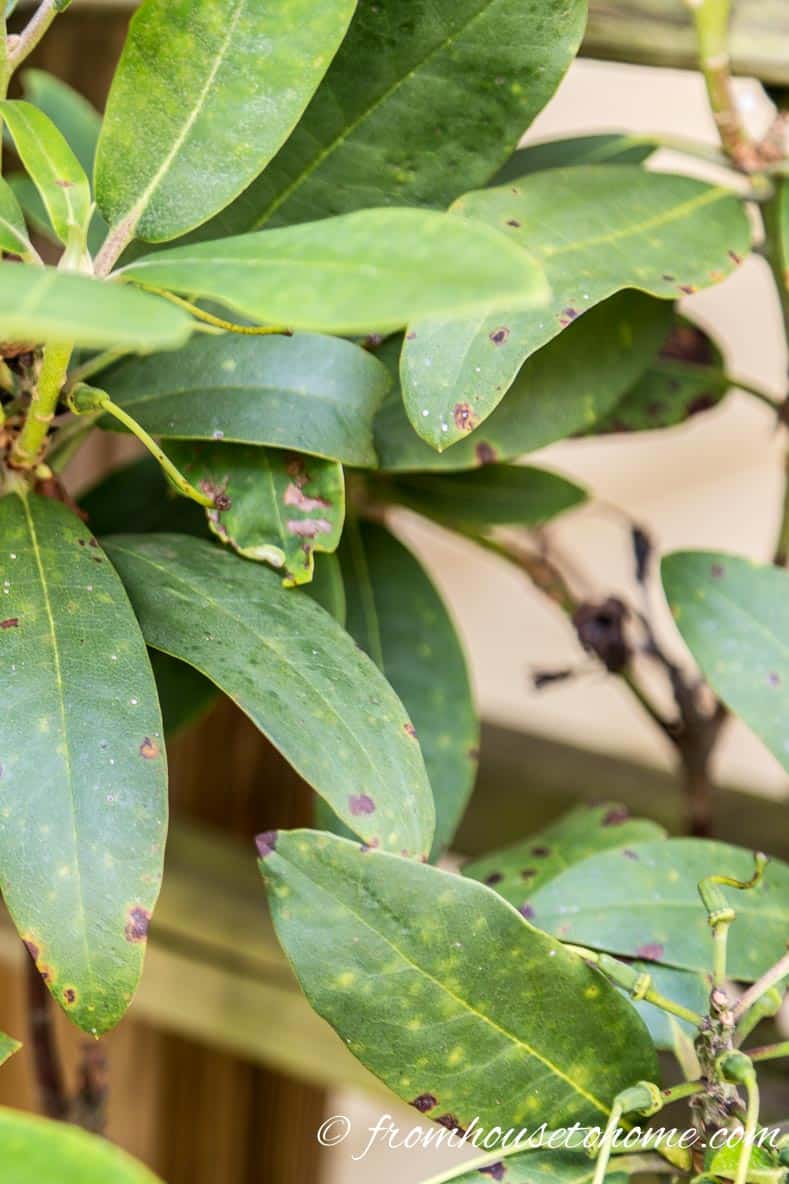
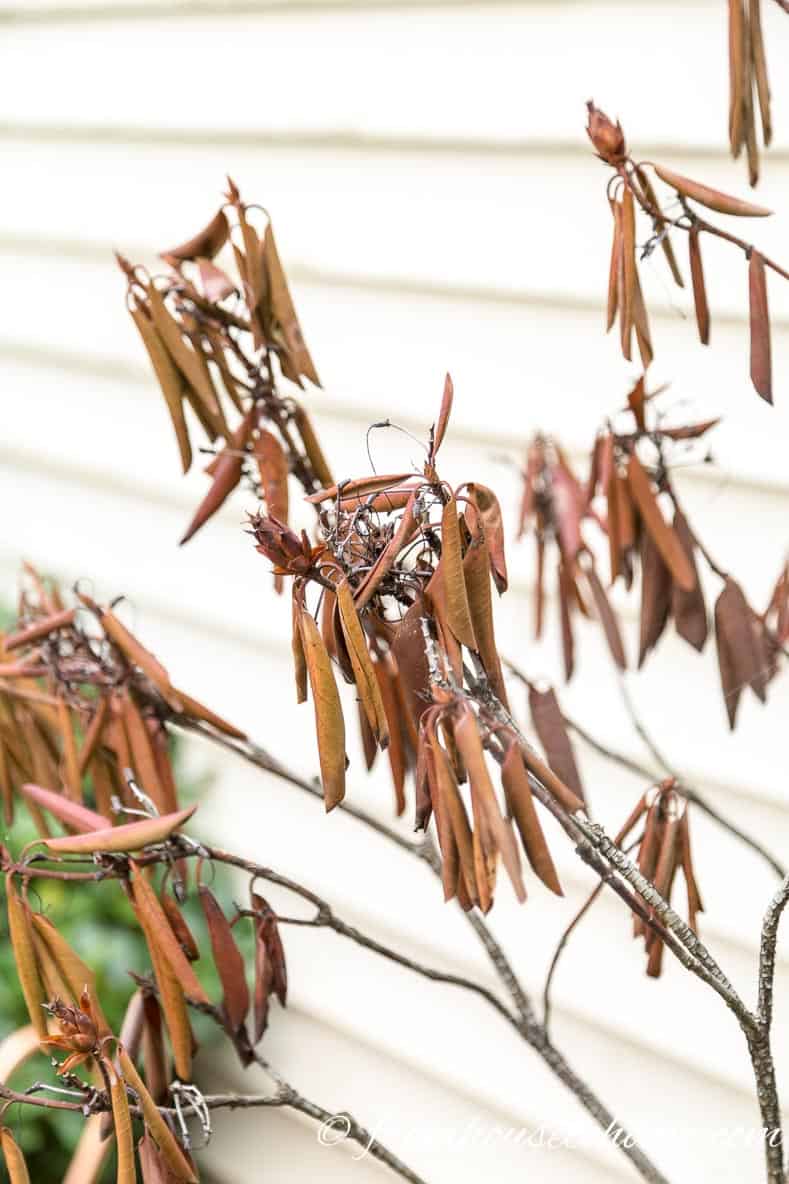
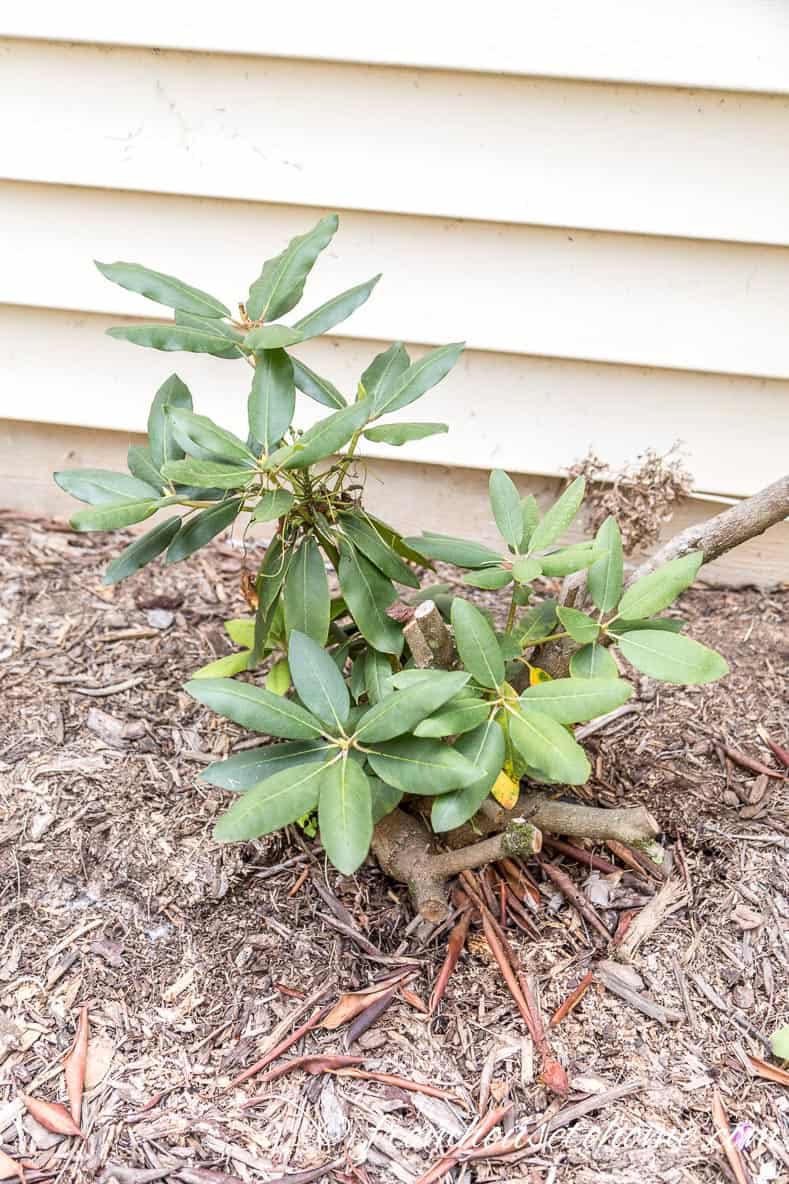
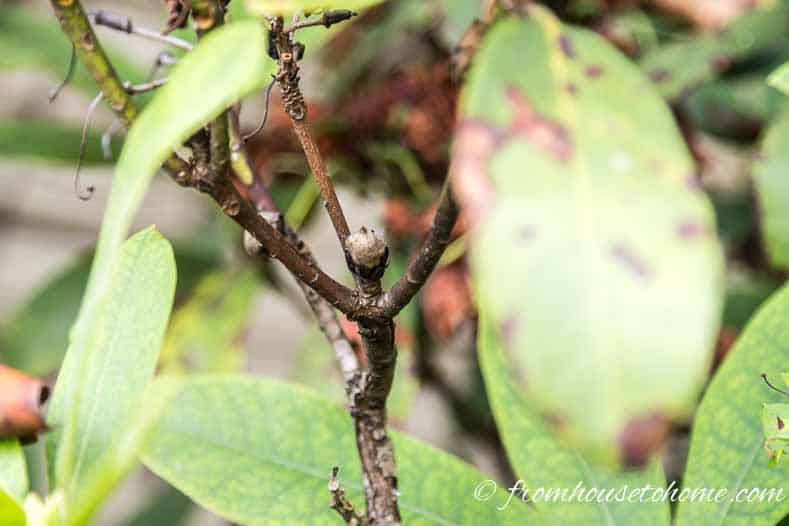

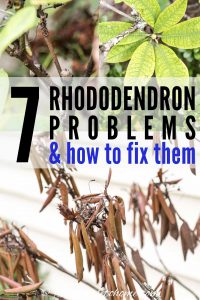
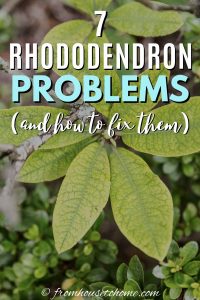
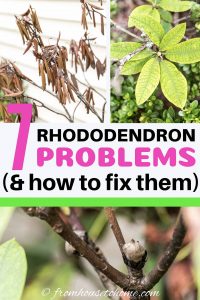
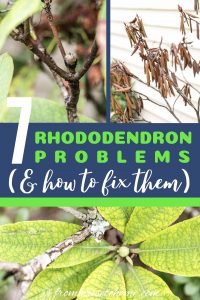
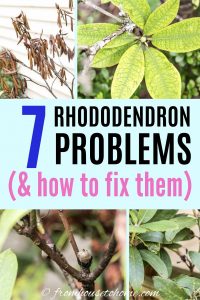
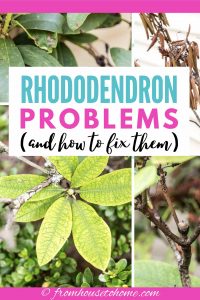
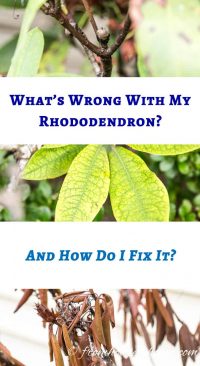
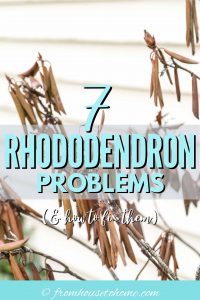
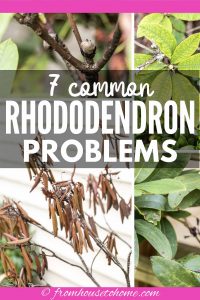

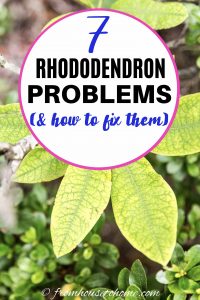
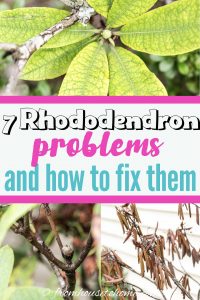
We moved into a 1970’s house four years ago. They back yard has great rhododendrons that we think were planted in the 70s when the house was built because the are all over 8 feet tall. One was taking over and an oak and blocking the sun from three other rhodies. We pruned it back (a year ago) and got rid on a lot of dead internal branches. The branches literally snapped off in your hands. I was cleaning up some wind fall lodges in it this year. Their a several strange branches. All are internal to the the bush. Each of these oddities is coming off of a single branch that was pointing down. There are six to eight tightly clumped branches pointing upward from each branch. They all have leaves and are together like a bouquet, about 1.5 feet long. It looks like if I cut one and put it in dirt another rhododendron would grown from the cluster. Do you know what are? Should I leave them alone or cut them out from the middle of the bush? Thanks for any incite you can provide.
Hi Katy…it sounds like witches’ brooms. It’s a genetic mutation which often can be cut off and transplanted to grow a dwarf version of the plant. Unless they’re diseased, they aren’t harmful to the plant. However, they can be caused by a fungi infection, so if the leaves get spots or don’t look healthy you will want to remove them. Otherwise it’s really up to you whether you prune them or leave them (depending on whether you like the look of it or not.)